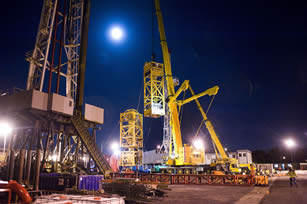Expro’s ground-breaking AX-S subsea well intervention system has been designed from the outset as a deepwater system, not merely an extension of surface or shallow water technology taken to depth.p style="margin-bottom: 0cm; text-decoration: none;">Expro’s ground-breaking AX-S subsea well intervention system has been designed from the outset as a deepwater system, not merely an extension of surface or shallow water technology taken to depth.
 OIL PRODUCTION IN West Africa is moving further away from shallow water and heading to deeper waters with several deepwater developments now up and running – deepwater intervention is now a must for operators globally, but especially in West Africa.
OIL PRODUCTION IN West Africa is moving further away from shallow water and heading to deeper waters with several deepwater developments now up and running – deepwater intervention is now a must for operators globally, but especially in West Africa.
Deepwater subsea development is really still in its infancy. Shallow-water fields can be accessed quickly by divers but moving into depths of 2,700-3,000 m has required technology advancements. As such, companies have been required to push the boundaries of technology in an effort to cost-effectively maximise production in deepwater, and develop methods for diagnosing and solving problem wells in these harsh conditions.
Subsea intervention is a crucial oilfield activity and has been practised for almost 20 years. In these challenging economic times, organisations are looking to increase reserves from new and existing developments. Intervention can be a key means of improving a well’s performance through, for example, increasing the hydrocarbon flow by re-perforating or improving lift performance. Surveillance and logging can provide data to help understand the current and future well performance, while vital repairs and inspection of trees and completions are required for safe well performance.
Until recently, the only method of entering a deepwater well to increase production or carry out maintenance activity was through use of a rig. This requires a riser or high-pressure mechanical conduit to be deployed between the rig and the well. With many rigs booked months or years in advance on drilling cycles, the cost of diverting it from this activity for a workover can be up to US$1,000,000 a day, meaning it may not be economically viable to intervene in a well.
The majority of new discoveries are made in deepwater regions such as offshore Gulf of Mexico, Brazil and West Africa. Drilling wells at depths up to 13.000 m can cost around US$150mn and operators cannot afford to abandon these wells with only a 25 per cent recovery rate.
To combat this issue, Expro’s AX-S system brings riserless intervention in up to 3,000 m of water, and provides a safer, deeper and more cost-effective alternative to using a rig or conventional wire-through-water intervention system.
With a depth capability of up to three kilometres below the sea surface, the AX-S has taken a fundamentally novel approach to the challenges faced at these depths, including minimising the number of down-lines, reducing reliance on complex ROV operations and eliminating dynamic seals where possible.
This deepwater capability makes the AX-S system particularly suitable for the deepwater regions of Africa, including Angola, Nigeria and elsewhere.
These subsea developments face unique challenges in terms of subsea equipment installed depth, high speed subsea current flows and logistical challenges of equipment and personnel, all of which demand the highest levels of equipment technical capability, reliability and functional service efficiency.
The deepwater West African subsea developments have always been one of the highest priority target markets for the AX-S system, which is the culmination of a US$150 million technology development by Expro.
The AX-S subsea well intervention system, developed by leading international oilfield service company Expro, is one of the most significant and innovative pieces of technology the subsea industry has seen. AX-S is designed to deliver a full range of wireline intervention services in deepwater wells at substantially less than the cost of using a rig.
The AX-S system is deployed onto a subsea tree with an active heave-compensated fibre winch from a monohull vessel, and is remotely controlled from the surface like a ROV. It consists of an integrated set of pressure-contained subsea packages comprising well control, wireline tools, wireline winch and fluid injection functions. A hydraulic plug-pulling tool overcomes the risks associated with pulling and setting tree crown plugs. A novel control umbilical overcomes the challenges of weight and size.
Discussions with a number of major operators were initiated in 2002 to determine the possibility of developing a cost-effective method of subsea well intervention which could operate at up to 3,000m. As the discussions progressed and industry demand increased, it became clear that a solution was required and in 2003, Expro began the AX-S research and development programme with part-funding from three major operating companies. A feasibility study was completed in 2004 and since then the design and testing of key components has been ongoing.
Expro is now at the end of the sixth year of a seven-year development and qualification program. The technology development is scheduled for completion by the end of 2010 and the first field test is scheduled to take place in a Norwegian fjord before the system is available commercially.
Once the system is fully commercialised, the deepwater offshore waters of West Africa, are key target markets. There has been significant industry demand and there are plans to construct numerous AX-S systems within the next 10 years.
The AX-S system is 33.5m tall, weighs 220t and is rated for operations at up to 3,000m. DNV (Den Norske Veritas) has independently provided hazard assessment and technical qualification throughout the development and testing program. Qualification testing at every step of development is critical to mitigate the risk of such a ground-breaking project.
The well control package (WCP) is the dual safety barrier containing industry-proven
7 3/8inch shear seal and gate valves. If any safety issues arise, the operator has time to identify the problem as the system is a fully-enclosed pressure housing with no dynamic seals between wellbore and surrounding environments.
Positioned directly above the WCP is the tool storage package (TSP). The TSP contains eight tool pockets which are located around the inner circumference of the package. The tools are swapped on the seabed and as they are held in a pressure retained housing, no pressure testing is required after each tool change.
The tools are run in the well by the wireline winch package (WWP). The pressure housing means issues such as hydrocarbon leaking into the surrounding water and water seeping into the well are all but eliminated. The winch has 25,000ft of mono-conductor which conveys the various intervention tools into the well. The fluid management package is the final subsea section and can deploy glycol fluid into the system to flush out hydrocarbons which are then circulated back into the well or subsea production system. Depending on the specific customer needs, sea water can be mixed with the fluid in variable ratios as required.
When comparing with rig-based interventions, the high operating cost and limited availability means that one operator in the Gulf of Mexico has budgeted about $35 million for a wireline intervention. Using the AX-S system would dramatically reduce these costs.
AX-S is safer because it is a pressure housing on top of a safety package. There is no stuffing box, or grease injection. Back deck operations to swap tools are eliminated. It is only necessary to disconnect the control umbilical for the supporting vessel to leave location, leaving the system as an additional safety barrier on top of the subsea tree.
AX-S is more cost-effective than alternative methods because it is supported from a monohull vessel, and is faster than wire-through-water solutions used in shallow water, especially on horizontal trees. Studies carried out by Expro indicate that AX-S is the only viable solution that is economically attractive for wireline intervention in deepwater wells.
Picture captions:
Expro 1 The AX-S deepwater intervention system during SIT





